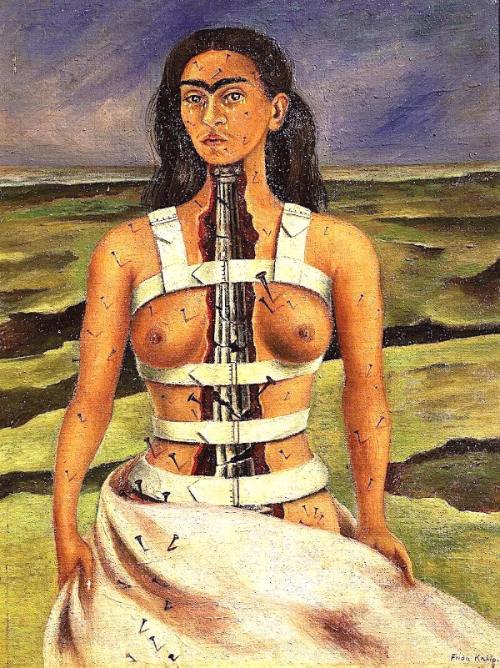
The Broken Column by Frida Kahlo
The broken column is one of the most emblematic works of Frida Kahlo: it is a self-portrait -specialty of the artist- that tells all the suffering of a life. Frida Kahlo painted The Broken Column in 1944, in the last period of her life, when physical pain prevented her from working and she had to wear a steel corset for several months. This work then reflects the pain she experiences in that period as well as since her accident – the painter suffered a serious truck accident at the age of seventeen that left her almost dead, all her life she suffered the physical consequences of this accident.
Frida is represented from the front, in the style of an American plan, only covered by some sheets and the corset she is wearing. His body opens from the neck to reveal the character’s spinal column, represented in the form of an Ionic column broken at numerous points. This opening is the symbol of the pain caused by the accident and the irreparable damage it inflicted on you. Indeed, in architecture as in anatomy, the column is the base on which everything else rests: if it is broken, the building can collapse at any moment. The column represents an essential element of the painting, it is worth noting that it is located exactly on the vertical axis of symmetry of the work and that the straps of the corset, which cut it perpendicularly, help draw the gaze towards it.
Broken Column painting
Likewise, suffering is also represented by the numerous nails found in his skin, as a symbol of pain points. We see, indeed, that they follow the path of his left leg, which suffered fractures at the time of his accident. However, the largest nail does not seem to designate physical but emotional pain, since it is located on the heart of the artist. It is very easy to imagine, then, that this element could be an echo of the painful love relationship with her husband, Diego Rivera. Finally, Frida’s gaze expresses an undeniable sadness, underlined by the numerous tears that run down her cheeks. This feeling is accentuated by the background of the work: a dry plain and a tormented sky, which appears as the very representation of loneliness. It is noteworthy that, unlike her self-portraits from the same period, she is not surrounded by flowers, monkeys or other animals, somewhat on a par with her first portrait (Self-Portrait in a Velvet Dress) whose background represented a sea of storms. However, it is necessary to emphasize that within his eyes two doves are drawn, a symbol of hope that contrasts with the apparent affliction of the character.
To conclude, this painting is very representative of Frida Kahlo’s work due to its autobiographical nature. Indeed, portraits and especially self-portraits are recurrent in the work of the Mexican artist and are usually true confessions. There, he paints the physical pain he experiences, which is also the symbol of another type of pain, more difficult to represent: that of love and betrayal. But although this work could be considered as a simple lamentation, it is also a figure of hope, since despite the broken column, the nails and the loneliness, the character remains firm, with a straight gaze, perhaps dreaming of better days.



